In March of 2023, following years of drought, California’s rain and snowfall reached unprecedented levels — surpassing the wettest winter in recorded history (1982-83) in some areas. The Sierra snowpack has exceeded its previous record, with more than 600 inches of snow since a parade of atmospheric river storms first made landfall in December. As of this writing, PG&E’s Emergency Operations Center has been open 40 out of the 76 days in 2023.
With the severity of these storms comes widespread damage and incredibly complex power restoration jobs, some that require snowcats, backhoes and days of digging just to access. With tens of thousands of people without power in potentially hazardous conditions, IBEW 1245 members from across California have been working tirelessly for many weeks in the hardest-hit parts of the state. Below, a few 1245 members share their storm stories.
Head on a Swivel
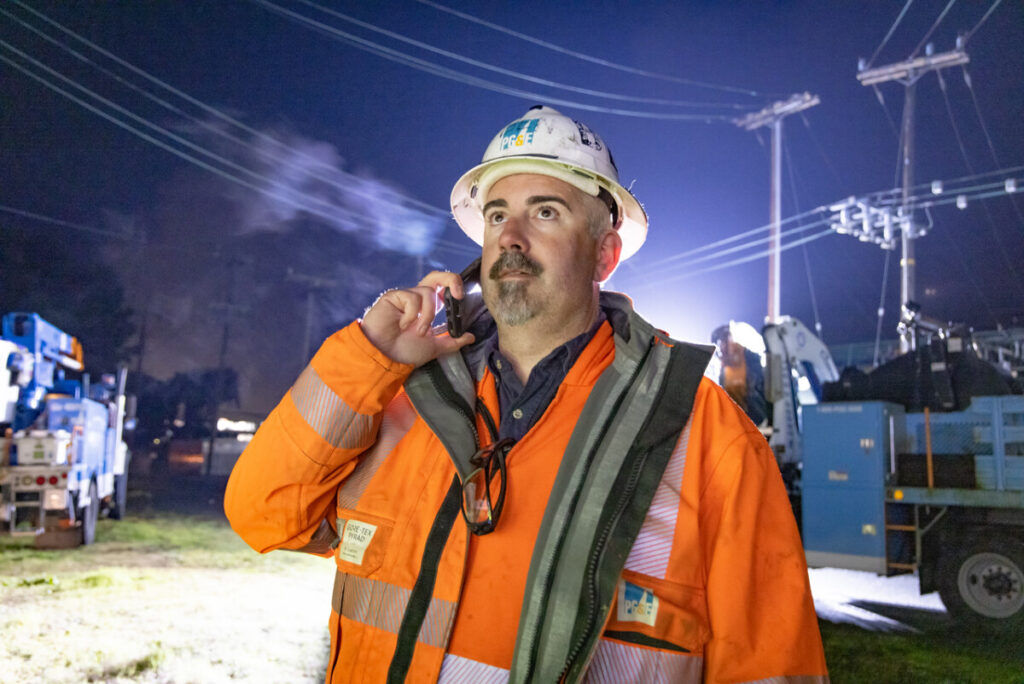
“You have to have an extreme tolerance for stress, I would say, and the ability to face that stress down and do the right thing even when you really, really don’t want to.” — Nine-Year IBEW 1245 member Ben Benton, GC Line Electric Crew Foreman, PG&E
In late February, the San Francisco Bay Area was the in the middle of a series of atmospheric river events that caused heavy flooding, spurred evacuations, and swept away structures.
On a busy ten-lane stretch of Highway 101 south of San Francisco, torrential rain and wind caused a tree to fall into a substation pole that had three circuits on it. A copper conductor that ran across Highway 101 had sagged low. A truck caught that conductor and broke poles that had three separate circuits on it, and caused an extended outage to 5,700 customers.
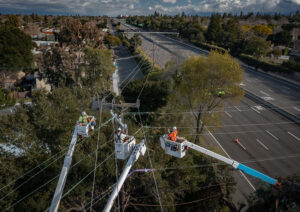
All ten lanes of Highway 101 near Menlo Park were closed to allow crews to repair damaged circuits and wire on February 23, 2023.
“If this job was down the residential sidewalk, if we could get buckets to it and shut the streets down … this job, with three circuits on it, would probably be a six or a seven (out of ten) on difficulty,” said Ben Benton, Electric Crew Foreman for PG&E and IBEW 1245 member. “You add in 10 lanes of [closed] freeway traffic that’s costing $4 million a minute, and it cranks it up to a stressful 10.”
“I went through IBEW apprenticeship, and I’ve been working overhead in the Bay Area, all around from the East Bay to San Francisco, to prepare me for this level of insanity,” Benton said. “I’d say the most difficult part of this job is to remind yourself not to take any shortcuts or half-ass anything, because the pressure is there, big time. Not out loud, but it’s there. There’s a lot of people out [of power], and there’s a lot of stuff going on.”
Handy with a Chainsaw
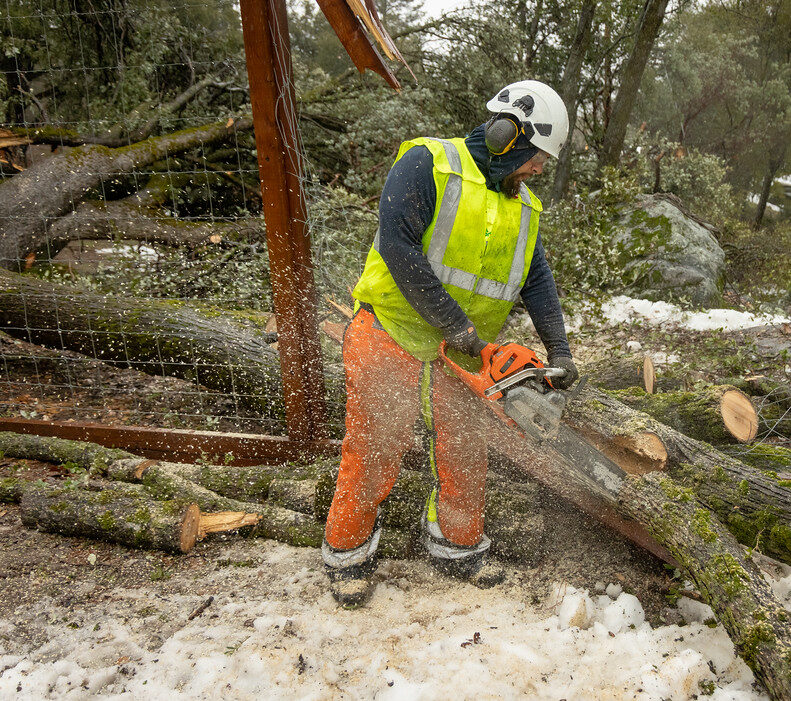
“We got to do what we got to do.” — Three-year IBEW 1245 member Reinaldo Andrade, Line Clearance Tree Trimmer Crew Foreman, ArborWorks
In the middle of a low-visibility rainstorm, Foreman Reinaldo Andrade and his crew set out to remove a tree that had fallen into a fence and then split a pole, knocking out power near the Oak Ridge area in Santa Clara county.
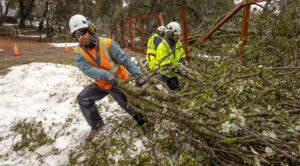
A crew from Arbor Works removes a tree from a PG&E site on March 14, 2023.
“You got to know your way around the chainsaw,” Andrade told us as his crew finished cutting out the tree, so a PG&E crew could come in and work on the downed line. “It takes a lot of time to get trained. You got to make sure you know where you’re putting the cuts, make sure the tree, the branches are not bouncing back, as well as looking over your crew members, make sure they’re out of the way, that you’re not cutting while they’re inside cutting branches. And basically, just make sure that PG&E and their crew can do the job safely.”
Putting the Public and Our Hometowns First
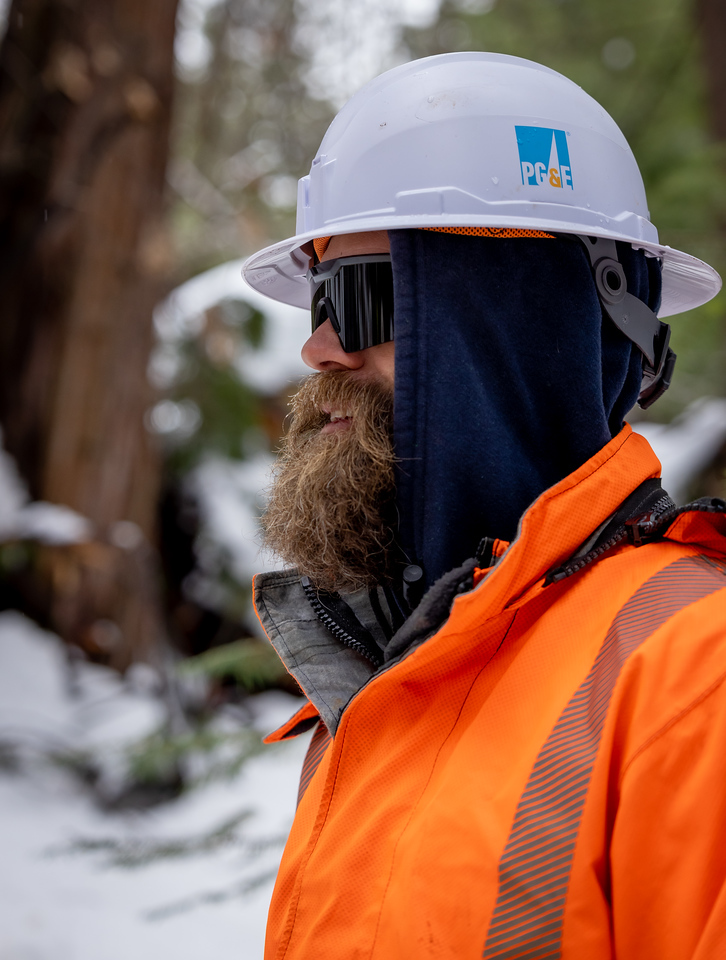
“Gotta have the resiliency to be out here, day in and day out, for our hometowns … we’re working long hours, weeks and weeks on end. So you’ve got to be able to roll with the punches.” – Nine-year IBEW 1245 member Rory Andersen, GC Sub Foreman, PG&E
In the Sierras and surrounding foothills, the winter snowpack has reached more than 200% of average – complicating efforts to find and rebuild damaged infrastructure. On Clipper Creek Road near Nevada City, PG&E GC Subforeman Rory Andersen and his crew had to dig for three days before getting access to a pole that needed to be repaired to reenergize a local neighborhood.
“Today we have a snowcat, we have a skid steer, we have a backhoe, and we have a line excavator for our pole set and getting a hole dug,” Andersen explained. “In this area, the most technical aspect of our work is going to be access. Environmental is a big part of it, and also the safety of my team, to get everybody back to their families at night, the way they showed up to work in the morning. You guys can see five feet of snow on the side of the road, they’re running multiple teams at a time to keep access moving, to get the power back on.”
 The crew has been working steadily since the start of the year, with one storm following another.
The crew has been working steadily since the start of the year, with one storm following another.
“I can say that supporting reliability would be our crews out here day in and day out, away from our families, putting the public and our hometowns first to keep everybody in power,” said Andersen. “There are a lot of elderly in this area that we’ve helped with snow plowing and just making sure to keep the lights on, keep the heat going.”

Crews dig and position a pole to restore power on March 9th.
“I’ve been a lineman for nine years, and in the trade for 14 years,” said Andersen. “I’ve come a long way… leaving the West Coast and going out to Nebraska, I traveled 15 states, did an IBEW apprenticeship, which was four years in length, and then spent four years at PG&E as a journeyman lineman before I made foreman to run a crew.”
“I’m very prideful in being able to work for Local 1245,” he said. “It’s always been a dream of mine since I started in this trade. They have made it possible to support my family, to raise young children and to do their best, to keep us safe. And I really do truly believe they put our best interests first before anything else. So I’m very proud to be a part of that.”
Photos above by John Storey
Photos below compiled by 1245 staff